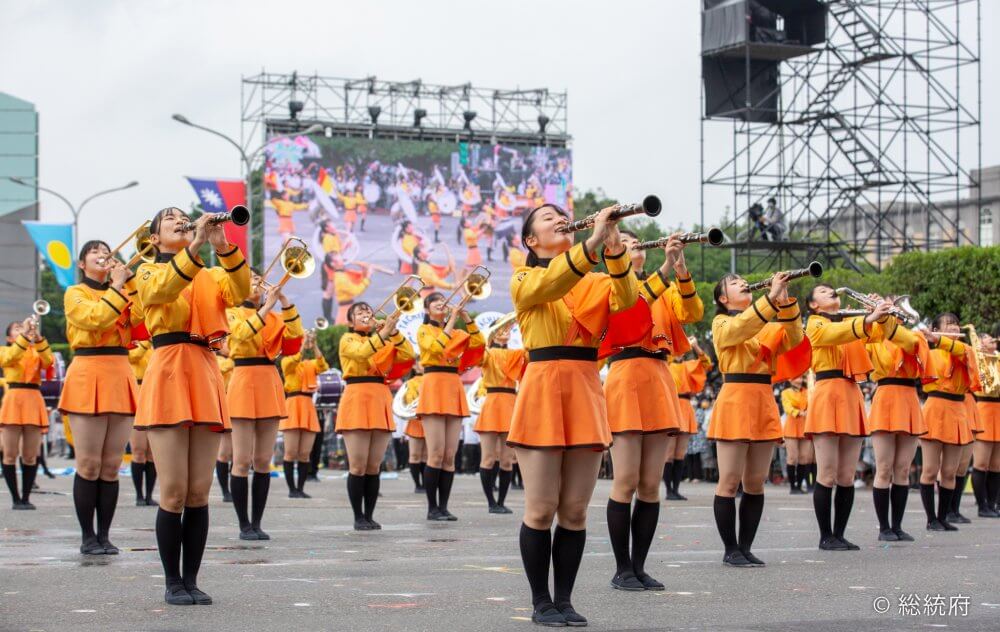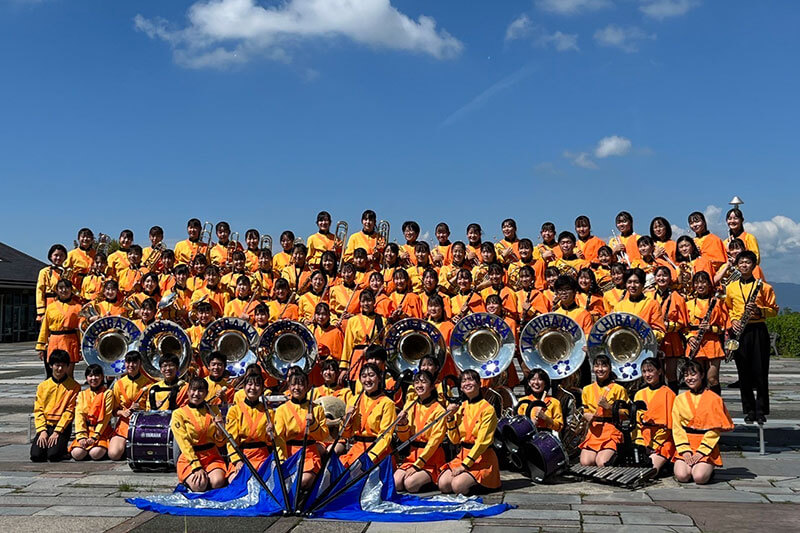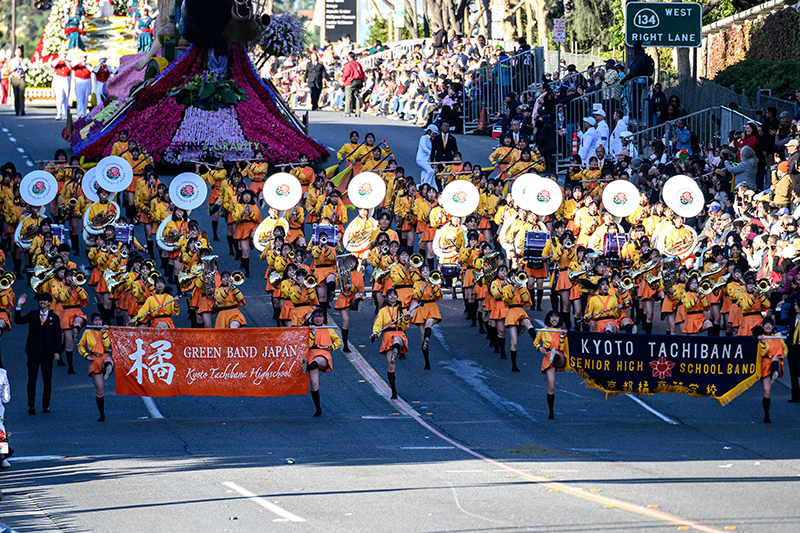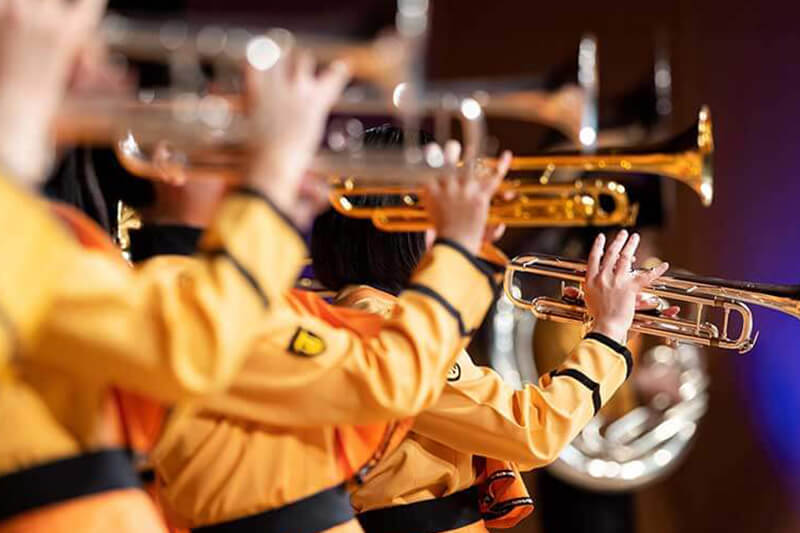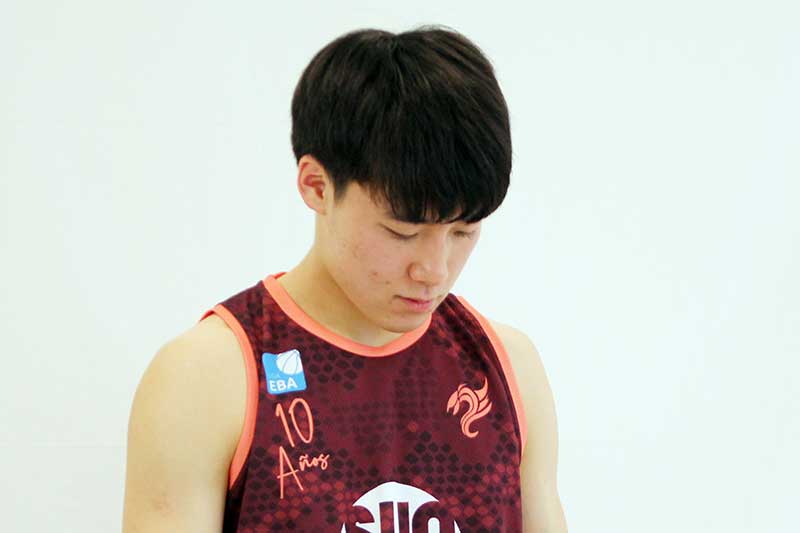Journal
サン・クロレラの取り組みや
サポートするアスリートたちのTOPICS。
Find out about Sun Chlorella's corporate activities and sponsored athletes
Kyoto Tachibana Senior High School Band

Kyoto Tachibana Senior High School Band is a marching brass band that has recently garnered worldwide attention. Their performance at the Rose Parade held in California from the end of 2011 to the beginning of 2012 captured the hearts of spectators in the United States, home of modern marching bands. Furthermore, the band was invited to perform in Taiwan this October to celebrate the National Day of Taiwan, where their remarkable performance was praised by President Tsai Ing-wen.
Standing in the center of this sensation, but still keeping a distance to maintain his objectivity, is Yutaka Kaneshiro, the band director. In the first half of this feature, we listen to him share about his journey with Kyoto Tachibana SHS Band.
Starting over and redefining an already established band
The day we visited the brass band club happened to be the same day when a video message was sent from President Tsai Ing-Wen of Taiwan, encouraging members of Kyoto Tachibana SHS Band, who were only days away from competing in the All Japan Marching Contest. The students cheered and mumbled excitedly as they focused on the screen. Yutaka Kaneshiro, on the other hand, watched the video quietly.
Kaneshiro was born in Iwakuni City, Yamaguchi Prefecture, in 1978. He became interested in music at the age of 10, when he happened to successfully make a sound using his older sister’s mouthpiece to play the flute. He then joined his elementary school’s brass band and began playing the trumpet. He continued to play music as he attended a local junior high and SHS in his hometown and majored in music at Shimane University’s Faculty of Education. Then, Kaneshiro decided to fly to Germany, where he trained under Bernhard Schmidt, a trumpet player of the Frankfurt Radio Symphony Orchestra. After a while he returned to Japan and studied brass band conducting from Masaru Nakai, a famous conductor who trained the Kudamatsu SHSBrass Band in Yamaguchi Prefecture. In 2008, Kaneshiro began teaching wind instrument music at a public high school in Kyoto. Then, in 2018, he became the band director of Kyoto Tachibana SHS Band through Masaru Nakai, a friend of Hisashi Hiramatsu, the first band director of the high school brass band who endorsed Kaneshiro to take over his position.
Kaneshiro: Mr. Hiramatsu contacted me and said we should have a talk, so we met at a café inside a hotel. When he told me the story, I was hesitant to accept his offer. I was a public high school teacher at the time, so joining a private high school meant that I had to leave the civil service. I also wondered how I could come in and direct a band that was already established. Then, to my surprise, Mr. Hiramatsu and Mr. Yoshiyuki Miwa, the school principal, told me, “Actually, we both hope that you would direct the band as if you’re starting from scratch.” Because they believed that much in me, I said yes. I thought, why not give it a try? And also because there’s no transferals when you’re teaching at a private school, I could settle down and direct the same band for a couple of decades like Mr. Hiramatsu did.
By the time Kaneshiro became the new band director, Kyoto Tachibana SHSBand was already quite popular in Japan because of their top-notch performances and TV appearances. Given the green light to basically start over, the first thing he focused on was to break old habits. Many marching brass bands in Japan tend to adopt rigid seniority-based rules that are seen in high school sports teams, perhaps because a lot of clubs tend to focus on the athletic element of marching over its musical aspect. Kyoto Tachibana SHS Band, too, was no exception at the time, which is why Kaneshiro decided to tackle their ways of communicating with one another, especially in the way senior students and drum majors held authoritative power over the band members and their juniors. As the new band director, Kaneshiro questioned this hierarchical atmosphere and instead encouraged lateral communication in the club. He also changed the decision-making process of selecting managerial positions and aimed to change the students’ way of thinking. Kaneshiro had his own philosophy toward wind instrument music.
Kaneshiro: Kyoto Tachibana SHS Band was already doing very successfully before I joined, so I’m not saying that the previous ways of doing things were all wrong. I can also definitely say that none of the students were wrong in any way. I had almost nothing else to add; they were already an amazing marching band. Which is perhaps why I wanted to reintroduce the fun of playing music together. And to do that, communication is key.
Because their performance is what garners attention, Kaneshiro wanted the band to remind themselves of their inherently high musical ability. He wanted to raise that level even higher, because a real marching band is a band that shows off its perfectly synchronized choreography on top of an amazing musical performance. He believed that his students definitely had it in them to make that happen. He joined the band, because somehow, he was already confident in the band.
The profoundness of 81 lives performing as one
Kyoto Tachibana SHS Band became known as the Orange Devils because of a TV show about eight years before Kaneshiro assumed his current position. After the show aired, various organizations from across Japan contacted the school to perform for them. The band tries to accept as much offers as possible depending on the terms and conditions, and has toured from Kyoto to Nagoya, Nagasaki, and back to Kyoto to play music. Their band activities must be physically exhausting for them, but the students seem to enjoy the challenge, saying, “it’s like going on a school excursion every day.”
And now, since their performance at the Rose Parade in California and the Chinese National Holiday parade in Taiwan this October, their destinations have expanded internationally. Today, their video clips of their performances that are uploaded on YouTube are gathering comments in multiple languages, reflecting their global influence.
Their idea to try taking Sun Chlorella was perhaps meant to be, since they needed to care for the students’ health maintenance and physical conditioning to deal with such a tough schedule.
Kaneshiro: Kyoto Tachibana SHS Band invites medical trainers to care for the students physically. I think that even on a nationwide level, it’s rare for a high school brass band to hire a medical trainer. We ask them to accompany us to competitions and concerts across the country to provide physical care such as massages. Performing wind instrument music is hard work, but on top of it, the students must walk and dance with their instruments. They use up a lot of energy. I’m that person who likes to try new things, and especially with the coronavirus pandemic, we just all really wanted to try something new. We then heard that the soccer club is taking Sun Chlorella, and seem to successfully maintain their physical wellbeing, so we joined them in taking the supplement last summer
Kaneshiro incorporates unique practice routines as well. At the beginning of every practice session, all members of the band first solve a series of calculations carried out on a 10-by-10 grid of numbers. According to Kaneshiro, this activates the brain and improves their reflexes that are necessary for playing music and helps them to focus and practice efficiently.
Kaneshiro has introduced new approaches to the band in terms of mental, technical, and physical aspects. What does he value the most as he directs his band and why?
Kaneshiro: In the end, I think it’s about growing as a person. That’s the most important purpose and a goal that we must strive towards. Improving musically and technically is important as well, but there are things that we can only do in senior high. And that’s growing as a person, and without it, I don’t think you can grow as a musician, because playing music is about expressing oneself as a performer. Aggressiveness, gentleness, grief, anger. Playing music involves sensitive and complex emotional expression, and that requires us to have various life experiences. The human emotion is not as simple as light and dark, or fun and sad. For example, there are many pieces with a rapid tempo and composed using the major scale with a melody that somehow sounds melancholy. This is because the producer is expressing complex emotions through music, and it’s hard to play it if you haven’t experienced the complexity of your own emotions. Which means that a good performer has gone through many experiences. The combination of emotions and life experiences is what makes a good performance.
Kaneshiro recalls a time when he said, “there’s a sense of vexing in this phrase” to which one first-year student asked, “what do you mean by vexing?” He thought, maybe that student has never experienced such an emotion. Which is why as the club advisor and moreover, a teacher, he intentionally provides opportunities for students to experience various emotions.
Kaneshiro: It’s not only music that I should teach. For example, it’s important in our daily lives to be conscious, notice little things and to take action, such as greeting people or picking up the trash, even. Furthermore, even if you can keep your awareness during your extracurricular activities, can you continue to be the same way during class or on the way home, with your family, or when no one is looking at you? This is what I talk to them all the time.
Noticing even the slightest changes in your daily life and building a habit of thinking for yourself allows you to work your sensors and see the world through your senses. That sensibility is what increases the students’ emotional intelligence, the depth of their music, and even takes them a step towards becoming a full-fledged human being.
Kaneshiro: “Let’s take a single dance step, for example. That step is a part of the entire choreography. It helps make a formation that involves everyone, and that’s how marching is composed. Besides marching, the band plays wind instrument music, which is a genre of music, which is part of the arts, which is part of culture, and culture is a part of civilization. By looking at our world objectively like this, I hope that my students also realize the importance of having a broad vision. If you’re too stuck on perfecting that one step, you may lose sight of the group’s balance and even your purpose, and hence you won’t be able to perform well. It’s also about life itself.
Lastly, Kaneshiro shared with us his favorite way to watch video clips of their performance.
Kaneshiro: When looking at our performance, please try to focus on one performer from the beginning to the end. In this way, you can see their movement and expression in detail compared to when you watch the group’s performance as a whole. You can see how they change over the course of the performance, which is different from other performers even in the same moment. There’s so much drama in each and every performer in a single piece. The parts that stand out and the parts that don’t, their different personalities, parents and families. They all practice with various thoughts and feelings and play together on the day of the performance. They each have their own story. Of course, you won’t be able to get much from footages. But if you focus on one performer and watch them as they they make a turn, line up, move forward, and perform steps, perhaps you’ll know what I mean. After you’ve watched until the end, then try focusing on a different performer. In a marching contest, the maximum number of performers is 81. If there are 81 members, then I recommend that you watch them 81 times by focusing on one performer at a time.
The way a performer lives their life is always expressed in the sounds they make. The band members each have their own story, which is why a masterpiece is born when all 81 stories come together, and hence moving the hearts of their audience. The Orange Devils, because they are so sincere in the music they play, are not only loved in Japan but in the U.S. and Taiwan as well. Together, especially when they perform, they bloom like a fresh bouquet of 81 Tachibana (citrus native to Japan) flowers. The spectacular and yet ephemeral aspect of wind instrument music and marching performed by young students is perhaps what makes them particularly moving.
